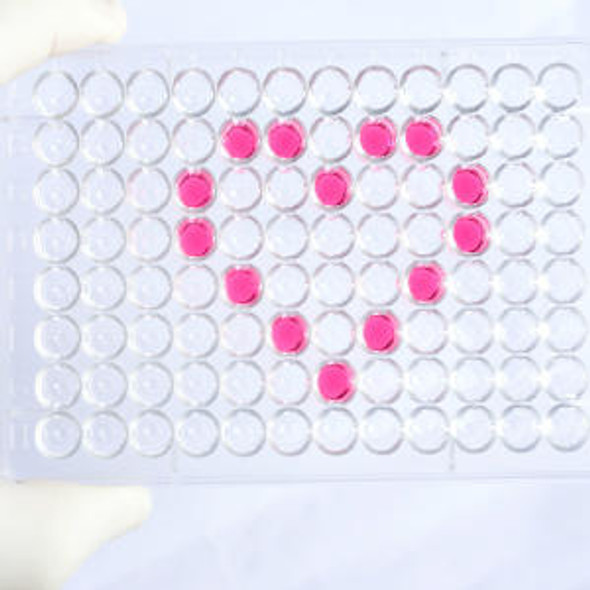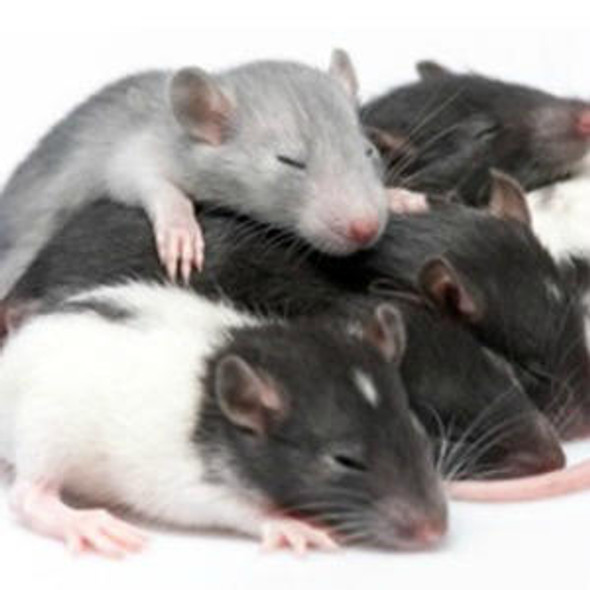Human DDOST ELISA Kit
- SKU:
- HUFI01761
- Product Type:
- ELISA Kit
- Size:
- 96 Assays
- Uniprot:
- P39656
- Sensitivity:
- 0.188ng/ml
- Range:
- 0.313-20ng/ml
- ELISA Type:
- Sandwich
- Synonyms:
- DDOST, OK, SW-cl.45, KIAA0115, OST48, DDOST 48 kDa subunit, Oligosaccharyl transferase 48 kDa subunit
- Reactivity:
- Human
- Research Area:
- Cell Biology
Description
Human DDOST ELISA Kit
DDOST encodes a component of the oligosaccharyltransferase complex which catalyzes the transfer of high-mannose oligosaccharides to asparagine residues on nascent polypeptides in the lumen of the rough endoplasmic reticulum. DDOST is also implicated in the processing of advanced glycation endproducts (AGEs), which form from non-enzymatic reactions between sugars and proteins or lipids and are associated with aging and hyperglycemia. Congenital disorder of glycosylation is one of the diseases associated with DDOST.
| Product Name: | Human DDOST ELISA Kit |
| Product Code: | HUFI01761 |
| Size: | 96 Assays |
| Alias: | DDOST, OK, SW-cl.45, KIAA0115, OST48, DDOST 48 kDa subunit, Oligosaccharyl transferase 48 kDa subunit |
| Detection method: | Sandwich ELISA, Double Antibody |
| Application: | This immunoassay kit allows for the in vitro quantitative determination of Human DDOST concentrations in serum plasma and other biological fluids. |
| Sensitivity: | 0.188ng/ml |
| Range: | 0.313-20ng/ml |
| Storage: | 4°C for 6 months |
| Note: | For Research Use Only |
| Recovery: | Matrices listed below were spiked with certain level of Human DDOST and the recovery rates were calculated by comparing the measured value to the expected amount of Human DDOST in samples. | ||||||||||||||||
| |||||||||||||||||
| Linearity: | The linearity of the kit was assayed by testing samples spiked with appropriate concentration of Human DDOST and their serial dilutions. The results were demonstrated by the percentage of calculated concentration to the expected. | ||||||||||||||||
| |||||||||||||||||
| CV(%): | Intra-Assay: CV<8% Inter-Assay: CV<10% |
| Component | Quantity | Storage |
| ELISA Microplate (Dismountable) | 8×12 strips | 4°C for 6 months |
| Lyophilized Standard | 2 | 4°C/-20°C |
| Sample/Standard Dilution Buffer | 20ml | 4°C |
| Biotin-labeled Antibody(Concentrated) | 120ul | 4°C (Protect from light) |
| Antibody Dilution Buffer | 10ml | 4°C |
| HRP-Streptavidin Conjugate(SABC) | 120ul | 4°C (Protect from light) |
| SABC Dilution Buffer | 10ml | 4°C |
| TMB Substrate | 10ml | 4°C (Protect from light) |
| Stop Solution | 10ml | 4°C |
| Wash Buffer(25X) | 30ml | 4°C |
| Plate Sealer | 5 | - |
Other materials and equipment required:
- Microplate reader with 450 nm wavelength filter
- Multichannel Pipette, Pipette, microcentrifuge tubes and disposable pipette tips
- Incubator
- Deionized or distilled water
- Absorbent paper
- Buffer resevoir
| Uniprot | P39656 |
| UniProt Protein Function: | DDOST: Essential subunit of N-oligosaccharyl transferase enzyme which catalyzes the transfer of a high mannose oligosaccharide to an asparagine residue within an Asn-X-Ser/Thr consensus motif in nascent polypeptide chains. Defects in DDOST are the cause of congenital disorder of glycosylation type 1R (CDG1R). A multisystem disorder caused by a defect in glycoprotein biosynthesis and characterized by under-glycosylated serum glycoproteins. Congenital disorders of glycosylation result in a wide variety of clinical features, such as defects in the nervous system development, psychomotor retardation, dysmorphic features, hypotonia, coagulation disorders, and immunodeficiency. The broad spectrum of features reflects the critical role of N-glycoproteins during embryonic development, differentiation, and maintenance of cell functions. Belongs to the DDOST 48 kDa subunit family. |
| UniProt Protein Details: | Protein type:EC 2.4.99.18; Glycan Metabolism - N-glycan biosynthesis; Membrane protein, integral; Endoplasmic reticulum; Transferase Chromosomal Location of Human Ortholog: 1p36.1 Cellular Component: endoplasmic reticulum membrane; protein complex; intracellular membrane-bound organelle; membrane; endoplasmic reticulum; oligosaccharyl transferase complex; integral to membrane Molecular Function:protein binding; dolichyl-diphosphooligosaccharide-protein glycotransferase activity; oligosaccharyl transferase activity Biological Process: SRP-dependent cotranslational protein targeting to membrane; cellular protein metabolic process; T cell activation; translation; response to cytokine stimulus; protein amino acid N-linked glycosylation; protein amino acid glycosylation; innate immune response; gene expression; protein amino acid N-linked glycosylation via asparagine; post-translational protein modification Disease: Congenital Disorder Of Glycosylation, Type Ir |
| NCBI Summary: | This gene encodes a component of the oligosaccharyltransferase complex which catalyzes the transfer of high-mannose oligosaccharides to asparagine residues on nascent polypeptides in the lumen of the rough endoplasmic reticulum. The protein complex co-purifies with ribosomes. The product of this gene is also implicated in the processing of advanced glycation endproducts (AGEs), which form from non-enzymatic reactions between sugars and proteins or lipids and are associated with aging and hyperglycemia. [provided by RefSeq, Jul 2008] |
| UniProt Code: | P39656 |
| NCBI GenInfo Identifier: | 239938926 |
| NCBI Gene ID: | 1650 |
| NCBI Accession: | P39656.4 |
| UniProt Secondary Accession: | P39656,O43244, Q5VWA5, Q8NI93, Q9BUI2, B2RDQ4, B4DJE3 B4DLI2, |
| UniProt Related Accession: | P39656 |
| Molecular Weight: | 49,020 Da |
| NCBI Full Name: | Dolichyl-diphosphooligosaccharide--protein glycosyltransferase 48 kDa subunit |
| NCBI Synonym Full Names: | dolichyl-diphosphooligosaccharide--protein glycosyltransferase subunit (non-catalytic) |
| NCBI Official Symbol: | DDOST |
| NCBI Official Synonym Symbols: | OST; WBP1; AGER1; CDG1R; OST48; OKSWcl45 |
| NCBI Protein Information: | dolichyl-diphosphooligosaccharide--protein glycosyltransferase 48 kDa subunit; oligosaccharyltransferase subunit 48; advanced glycation endproduct receptor 1; oligosaccharyltransferase 48 kDa subunit; oligosaccharyl transferase 48 kDa subunit; dolichyl-diphosphooligosaccharide-protein glycotransferase |
| UniProt Protein Name: | Dolichyl-diphosphooligosaccharide--protein glycosyltransferase 48 kDa subunit |
| Protein Family: | Dolichyl-diphosphooligosaccharide--protein glycosyltransferase |
| UniProt Gene Name: | DDOST |
| UniProt Entry Name: | OST48_HUMAN |
*Note: Protocols are specific to each batch/lot. For the correct instructions please follow the protocol included in your kit.
Before adding to wells, equilibrate the SABC working solution and TMB substrate for at least 30 min at 37°C. When diluting samples and reagents, they must be mixed completely and evenly. It is recommended to plot a standard curve for each test.
| Step | Protocol |
| 1. | Set standard, test sample and control (zero) wells on the pre-coated plate respectively, and then, record their positions. It is recommended to measure each standard and sample in duplicate. Wash plate 2 times before adding standard, sample and control (zero) wells! |
| 2. | Aliquot 0.1ml standard solutions into the standard wells. |
| 3. | Add 0.1 ml of Sample / Standard dilution buffer into the control (zero) well. |
| 4. | Add 0.1 ml of properly diluted sample ( Human serum, plasma, tissue homogenates and other biological fluids.) into test sample wells. |
| 5. | Seal the plate with a cover and incubate at 37 °C for 90 min. |
| 6. | Remove the cover and discard the plate content, clap the plate on the absorbent filter papers or other absorbent material. Do NOT let the wells completely dry at any time. Wash plate X2. |
| 7. | Add 0.1 ml of Biotin- detection antibody working solution into the above wells (standard, test sample & zero wells). Add the solution at the bottom of each well without touching the side wall. |
| 8. | Seal the plate with a cover and incubate at 37°C for 60 min. |
| 9. | Remove the cover, and wash plate 3 times with Wash buffer. Let wash buffer rest in wells for 1 min between each wash. |
| 10. | Add 0.1 ml of SABC working solution into each well, cover the plate and incubate at 37°C for 30 min. |
| 11. | Remove the cover and wash plate 5 times with Wash buffer, and each time let the wash buffer stay in the wells for 1-2 min. |
| 12. | Add 90 µl of TMB substrate into each well, cover the plate and incubate at 37°C in dark within 10-20 min. (Note: This incubation time is for reference use only, the optimal time should be determined by end user.) And the shades of blue can be seen in the first 3-4 wells (with most concentrated standard solutions), the other wells show no obvious color. |
| 13. | Add 50 µl of Stop solution into each well and mix thoroughly. The color changes into yellow immediately. |
| 14. | Read the O.D. absorbance at 450 nm in a microplate reader immediately after adding the stop solution. |
When carrying out an ELISA assay it is important to prepare your samples in order to achieve the best possible results. Below we have a list of procedures for the preparation of samples for different sample types.
| Sample Type | Protocol |
| Serum | If using serum separator tubes, allow samples to clot for 30 minutes at room temperature. Centrifuge for 10 minutes at 1,000x g. Collect the serum fraction and assay promptly or aliquot and store the samples at -80°C. Avoid multiple freeze-thaw cycles. If serum separator tubes are not being used, allow samples to clot overnight at 2-8°C. Centrifuge for 10 minutes at 1,000x g. Remove serum and assay promptly or aliquot and store the samples at -80°C. Avoid multiple freeze-thaw cycles. |
| Plasma | Collect plasma using EDTA or heparin as an anticoagulant. Centrifuge samples at 4°C for 15 mins at 1000 × g within 30 mins of collection. Collect the plasma fraction and assay promptly or aliquot and store the samples at -80°C. Avoid multiple freeze-thaw cycles. Note: Over haemolysed samples are not suitable for use with this kit. |
| Urine & Cerebrospinal Fluid | Collect the urine (mid-stream) in a sterile container, centrifuge for 20 mins at 2000-3000 rpm. Remove supernatant and assay immediately. If any precipitation is detected, repeat the centrifugation step. A similar protocol can be used for cerebrospinal fluid. |
| Cell culture supernatant | Collect the cell culture media by pipette, followed by centrifugation at 4°C for 20 mins at 1500 rpm. Collect the clear supernatant and assay immediately. |
| Cell lysates | Solubilize cells in lysis buffer and allow to sit on ice for 30 minutes. Centrifuge tubes at 14,000 x g for 5 minutes to remove insoluble material. Aliquot the supernatant into a new tube and discard the remaining whole cell extract. Quantify total protein concentration using a total protein assay. Assay immediately or aliquot and store at ≤ -20 °C. |
| Tissue homogenates | The preparation of tissue homogenates will vary depending upon tissue type. Rinse tissue with 1X PBS to remove excess blood & homogenize in 20ml of 1X PBS (including protease inhibitors) and store overnight at ≤ -20°C. Two freeze-thaw cycles are required to break the cell membranes. To further disrupt the cell membranes you can sonicate the samples. Centrifuge homogenates for 5 mins at 5000xg. Remove the supernatant and assay immediately or aliquot and store at -20°C or -80°C. |
| Tissue lysates | Rinse tissue with PBS, cut into 1-2 mm pieces, and homogenize with a tissue homogenizer in PBS. Add an equal volume of RIPA buffer containing protease inhibitors and lyse tissues at room temperature for 30 minutes with gentle agitation. Centrifuge to remove debris. Quantify total protein concentration using a total protein assay. Assay immediately or aliquot and store at ≤ -20 °C. |
| Breast Milk | Collect milk samples and centrifuge at 10,000 x g for 60 min at 4°C. Aliquot the supernatant and assay. For long term use, store samples at -80°C. Minimize freeze/thaw cycles. |
Fill out our quote form below and a dedicated member of staff will get back to you within one working day!






